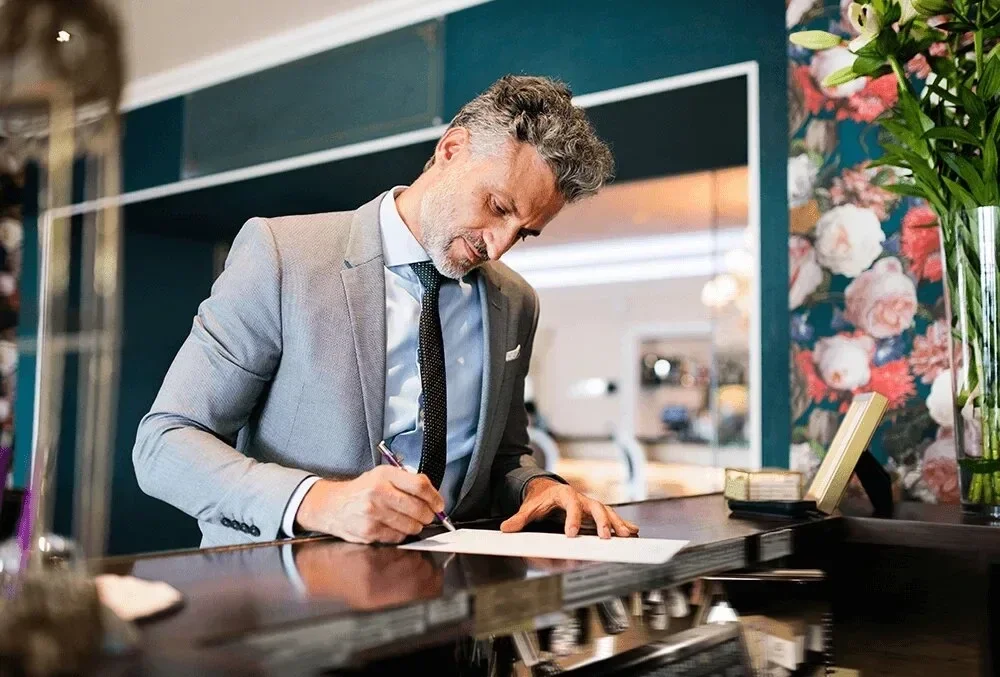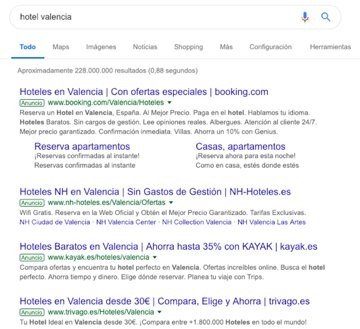Estrategia de Google y Facebook para OTAs
Como todos sabemos, actualmente el sector turístico es altamente competitivo, por eso definir una estrategia de SEM, Google y Facebook para OTAs supone todo un desafío. ¿Cómo lo hemos hecho nosotros? Te lo contamos en este post.
El marketing de OTAs y hoteles se encuentra en una fase de constante cambio en los últimos años. El continuo crecimiento de las plataformas online, la creciente presencia de los dispositivos móviles y los cambios en la demanda están transformando cómo se buscan y se reservan los alojamientos.

Hoy hablamos de la definición de la estrategia de uno de nuestros clientes más grandes, una OTA en la que empezamos a trabajar en verano de 2017, para la que definir una estrategia de SEM y Facebook fue imprescindible.
Análisis inicial del cliente
Nuestro cliente ya tenía creada una cuenta en Google Ads y había lanzado una serie de campañas de búsqueda en Google, pero no contaba con un equipo especializado que las trabajara.
Por otro lado, Facebook Ads también es una gran plataforma para un cliente de este tipo, sobre todo con la alta competencia que existe actualmente en este sector, que nos obliga a estar presentes también en este canal. El cliente no contaba con una cuenta publicitaria, así que nosotros empezamos desde cero siempre como complemento a las campañas de búsqueda.
Con todo esto empezamos a definir una estrategia de SEM y Facebook para esta OTA desde el inicio, la cual os presentamos hoy en forma de guía.
Definición de la estrategia de Google
Fase 1. Objetivos y estructura de las campañas de Google Ads
Nuestro primer paso fue definir de una manera clara nuestros objetivos. Las campañas iniciales no tenían ninguna estructura, por lo que no se podían alcanzar los objetivos definidos por la empresa: aumentar las ventas en las diferentes plataformas digitales que utilizamos.
Después de estudiar sus peculiaridades y realizar un análisis de las ventas del año anterior, pusimos en marcha un plan para reestructurar toda la cuenta de Google Ads.
- El cliente ya se había focalizado en campañas de nicho que nos parecían muy interesantes y concentraban gran parte de las ventas, por lo que además de empezar con la creación de nuevas campañas nos centramos en optimizar éstas. También fijamos los objetivos, tanto sobre dónde focalizarnos, como de resultados. En este caso decidimos fijar como objetivo obtener un ROAS de 20, el cual mantenemos a día de hoy.
- Creamos diferentes cuentas publicitarias dentro de un mismo MCC, ya que como contamos con un alto volumen de campañas las diferenciamos por zonas geográficas. Esto también nos permite optimizarlas de manera muy distinta según sus tendencias y seguir creciendo a nivel cuantitativo.
- Empezamos con el lanzamiento de dos tipos de campañas “always-on”: genéricas y de hotel. Las genéricas son aquellas que nos llevan a búsquedas de un destino (“hoteles en Madrid”), también diferenciándolas por facilities (“hoteles 3 estrellas en Madrid”); y por otro lado tenemos las campañas de hotel, que cubren las búsquedas de un hotel en concreto.
Fase 2. Apostar por una segmentación relevante
Dentro de este sector la competencia es muy alta, por lo que se tiene que trabajar de una manera óptima e investigar lo más profundamente posible para conseguir nuestros objetivos.
- Hemos incluido palabras clave muy específicas, así como hecho investigaciones con la herramienta Keyword Planner para incluir aquellos términos que utilizan los usuarios al realizar una búsqueda de travel.
- Trabajamos con anuncios 100% relacionados con cada una de ellas, para así poder ganar calidad y relevancia y conseguir la mayor visibilidad posible.
- También utilizamos todo tipo de extensiones, que ofrecen información más detallada sobre los hoteles, destinos, paquetes turísticos y promociones actuales.
Con todo esto tenemos un total de 2.900 campañas activas, no solo lanzadas en Google Ads, sino también en Bing, aumentando así el alcance de nuestros anuncios y las probabilidades de impactar a nuestro cliente potencial.
Fase 3. Optimización y creación de Landing Pages
Una vez acabadas las primeras fases y montada la nueva estructura, nos centramos en la maximización de la tasa de conversión y el “re-styling” de la web.
Para ello, hicimos una propuesta para empezar con la creación de landing pages específicas para cada uno de los nichos que atacamos, para que el usuario tuviera una continuidad con lo que había visto en el anuncio y así captar más su atención y facilitar la conversión.
Fase 4. Creación de listas de audiencias y anuncios con función IF
Cuando empezamos a tener un cierto histórico creamos distintas listas de audiencias según visitantes en:
- Landings de nicho
- Determinados destinos
- Hoteles TOP
- Entradas específicas del blog
- Duración de las sesiones
- Páginas por sesión
- Convertidores
Gracias a estas audiencias hemos podido incluir anuncios con función “IF” en todas las campañas que mostrarán un mensaje específico en el texto del anuncio dependiendo de a quién se le esté mostrando. Por ejemplo, en el caso de usuarios que ya han reservado se les puede mostrar un cupón descuento en su próxima reserva.
Fase 5. Campañas de Display
En este caso hemos utilizado las campañas de Display en temporadas y festividades específicas, siempre apuntando a un público de remarketing. Es decir, re-impactamos a aquellos usuarios que ya han buscado dentro del intervalo de fechas de cada campaña.
Además, tenemos activa una campaña de Smart Display “always-on” que nos permite, de manera eficaz, conseguir reservas a nuestro CPA objetivo, y muestra nuestros anuncios en todos los formatos a través de la Red de Display de Google.
De esta manera podemos llegar a nuestra audiencia en cualquier etapa del ciclo: tanto a los usuarios que han mostrado interés en algún hotel o destino como a aquellos que están apunto de reservar.
*Resultados Campaña Smart Display
Fase 6. Tareas de optimización
Después de todos estos pasos, lo más importante es llevar a cabo un trabajo de optimización diario, sobre todo en clientes como éste con un volumen de campañas tan alto. Algunos recursos que utilizamos para ello son:
- Scripts: hacemos uso de gran variedad de scripts para nuestro cliente, tanto de mapas de calor y programación horaria, como de términos de búsqueda, etc.
- Reglas automatizadas: también hemos creado reglas automatizadas en Google Ads para que nos ayuden a detectar los distintos escenarios que van ocurriendo y nos notifique por email. Esta herramienta es imprescindible en una cuenta con tanto volumen de campañas.
- Automatic bidding: también utilizamos una herramienta que nos permite ajustar automáticamente las pujas en una gran cantidad de variables: CPC’s, ubicaciones, edades, sexos… y a su vez nos genera informes muy útiles tanto para nosotros como para el mismo cliente.
- Revisión de dispositivos: los usuarios cada vez confían y reservan más a través de smartphones (el 42% de los consumidores utiliza su móvil para buscar inspiración para su próximo viaje), mientras que el uso del ordenador se mantiene, sobre todo a la hora de buscar alojamiento, no de reservarlo. Por esta razón, tenemos en mente un enfoque “mobile-first” cada vez más acentuado y revisamos los dispositivos semanalmente.
- Anuncios adaptables: esta nueva novedad de Google Ads nos permite, en un mismo anuncio, probar todos los copies y descripciones que tenemos en funcionamiento a nivel individual, para que la herramienta muestre la versión más relevante para el usuario. Esto nos es muy útil en un cliente con tanto volumen y tan gran cantidad de anuncios activos.
- Continua creación de campañas según zonas y temporalidad: estamos en contacto continuo con nuestro cliente y sus proveedores para cubrir cada vez más zonas geográficas e ir aumentando progresivamente el número de hoteles donde ya estamos presentes.
Estrategia de Facebook para OTAs
El contenido visual cada vez es más efectivo e influye más en el proceso de decisión del usuario, sobre todo en la fase de planificación de un viaje, cuando la mayoría de usuarios visualiza diversos tipos de contenido: casi un 50% visita webs de viajes, un 30% redes sociales y el 20% restante visualiza algún tipo de vídeo.
- Dinámicas de remarketing: para la cual subimos el catálogo de hoteles y la herramienta se encarga de mostrar al usuario los que ya ha visto en la web.
- Puntuales según época del año y festividades: donde hacemos tanto prospección como remarketing.
- Promociones de paquete turísticos, escapadas, e incluso espectáculos.
*Resultados de la campaña dinámica que estamos trabajando de manera continua.
Para todas ellas se han utilizado públicos de todo tipo:
- Remarketing de usuarios que nos han visitado pero no reservado.
- Remarketing de clientes que han viajado en períodos específicos de años anteriores.
- Públicos similares a aquellos usuarios que ya han buscado y/o realizado reservas.
- Bases de datos de clientes.
Además de las campañas con objetivo compra, también hemos probado las campañas de “Consideración”, en este caso con objetivo “Mensajes”.
Éstas las lanzamos con el fin de que los usuarios abrieran conversaciones con nuestro cliente a través de Messenger, y nos han permitido generar clientes potenciales y ofrecer asistencia durante todo el proceso de reserva.
Con ella hemos obtenido muy buenos resultados, ya que conseguimos que el usuario pasara de la consideración a la acción, y de un total de 109 conversaciones, muchas de ellas se convirtieron finalmente en reservas.

*Resultados de la campaña de Messenger
Esperamos que estas estrategias de SEM y Facebook para OTAs te ayuden a partir de ahora a sacar el máximo partido a tus campañas y que puedas analizarlas día tras día con la ayuda de nuestros trucos e indicaciones.
Si deseas conocer más trucos para Google Ads y Facebook no dudes en visitar nuestro blog en las próximas semanas. ¡Te esperamos!





